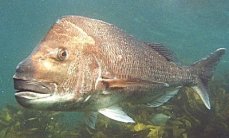 These
fish are found, often in abundance, throughout the northern part of New Zealand.
They generally live in the deeper waters of the reef in large schools between 3 - 50 mts (10 - 160ft). However they quite often they forage for food or spawn in the shallow waters of estuaries
and harbours.
These
fish are found, often in abundance, throughout the northern part of New Zealand.
They generally live in the deeper waters of the reef in large schools between 3 - 50 mts (10 - 160ft). However they quite often they forage for food or spawn in the shallow waters of estuaries
and harbours.
They are an active, schooling fish with elongated bodies, large mouths, sharp canine teeth, and blunt or forked tails, snappers are usually rather large, many attaining a length of 60-90 centimetres (2-3 ft), though the average size would be 30 - 50 cm (1-1.½ ft) and weigh in at between .5 -2.5kg (1-5 lbs).
Snapper are a goldish pink to red in colour over their top and sides, and a paler white below. Sometimes you can see many blue spots along their sides, particularly in the younger fish.
Individual fish found inside muddy harbours and estuaries sometimes tend to be a darker pale pink, whilst fish found around reefs and over weed areas are a darker red to bronze colour.
Like many other sea creatures, snapper feel vulnerable when out in the open, especially when the water is shallow enough to be well illuminated by the sun. As a result, they either move into deeper water during bright conditions or hide in gutters and amongst areas of weed, waiting for darker conditions so that they can come back out and forage.
This fish is a Carnivore and will eat crustaceans like crabs, shrimp and shellfish along with other smaller marine fishes. Like most Carnivores, if it is something they can get their mouth around they will try and eat it.
Snapper spawn in the spring and summer seasons usually in estuaries, shallow harbours and some bays.
The eggs float near the surface for a few days befor hatching. After a month or two they become a miniture replica of the adults and are about 25mm (1") long. They live in these estuaries and harbours during the first summer then move into slightly deeper costal waters in the winter.
Adult snapper are generally between 5-10 years old, and snapper on the west coast grow faster than snapper on the East coast.
From my own experience I have not see this fish when I am diving until I am at about 50-60 feet. However on occasion I have swum in shallower water around a rocky outcrop and have come across them just a few feet away. I beleive the best place for people to observe these fish would be at the Goat Island reserve just north of Leigh, about an hour and a half drive north of Auckland.